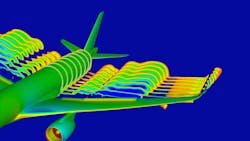Aerodynamics and the art of aircraft design
COLOGNE, Germany - Decarbonization of aviation relies on a combination of many incremental steps and outright technological breakthroughs. To succeed, both approaches need to exist inside a collaborative ecosystem. In this spirit, Airbus and two leading European research institutions, DLR and ONERA, are exploring how high-performance computing can improve our understanding of the relationship between aerodynamics and aircraft efficiency, the German Aerospace Center reports. Continue reading original article.
The Military & Aerospace Electronics take:
3 February 2023 - Computational fluid dynamics (CFD) combines applied mathematics, physics and high-performance computing. It’s used to understand how air moves over complex shapes, helping designers maximize lift and minimize drag to make an aircraft as efficient as possible at both low and high speeds.
“I always say that CFD is where science meets art. It’s a beautiful thing, a kind of computerised wind tunnel,” grins Airbus’ Head of Aerodynamics Simon Galpin. Galpin oversees a five-year-old partnership with French aerospace lab ONERA (Office National d'Etudes et de Recherches Aérospatiales) and the German Aerospace Center DLR (Deutsches Zentrum für Luft- und Raumfahrt) on behalf of Airbus.
DLR and ONERA are decades-long Airbus partners. Historically each had worked on separate computer codes, the foundations on which CFD is built. Although the codes were effective in their own right, communication between the different development teams was limited.
Gradually it became clear that the codes required collective re-engineering for extreme-scale parallel computing platforms. The partnership addresses that shortfall. “It made sense to combine our efforts,” says Galpin. “We’re developing a new generation CFD code that is ‘industry-ready’ for flow prediction and equally applicable to aircraft, helicopters and space systems.”
Related: NASA and DLR jointly developing quantum computer software package
Related: NASA-DLR study finds sustainable aviation fuel can reduce contrails
Related: DLR taps Airbus for first-ever in-orbit verification of laser-optical clocks
Jamie Whitney, Associate Editor
Military + Aerospace Electronics
